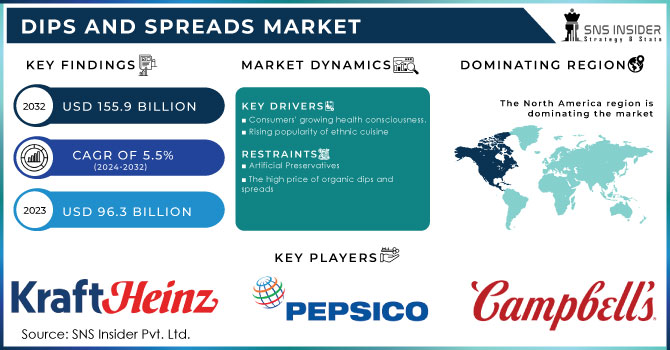Dips and Spreads Market Report Scope & Overview:

Get More Information on Dips and Spreads Market - Request Sample Report
The Dips and Spreads Market size was USD 96.3 billion in 2023 and is expected to Reach USD 155.9 billion by 2032 and grow at a CAGR of 5.5 % over the forecast period of 2024-2032.
The rise of health-conscious customers and the trend toward healthy eating habits have increased demand for dips and spreads. Various cuisines go well with many different Dips and Spreads. North America, in particular, is where most of these dips and spreads are consumed.
By type, the market is fragmented into Hummus, Mayonnaise, Guacamole, Salsa, Cheese Spreads, Vegetable Dips, and Others. In 2022, the Hummus segment generated approximately USD 24.2 billion in revenue. It has shown a remarkable growth over the forecasted period. Hummus is a tasty Dip and Spread made with chickpeas, spices, tahini, and lemon juice. It is popular in the Mediterranean and the Middle East. Because of its excellent plant-based protein content, nutritional value, and minimal saturated fat, it is seen as a healthier alternative to typical spreads.
Also, the cheese dip segment is the fastest-growing segment due to a wide array of cheese dips has made their place in the market such as hot cheese dip, cream cheese dip, garlic cheese dip, and others. The demand for cheese is high as it has become an essential component in many cuisines.
During the projection period, the online retail segment is expected to grow at a CAGR of more than 5.1%. Online retail provides the ease of home delivery, which appeals to customers who want to shop from the comfort of their own homes.
MARKET DYNAMICS
KEY DRIVERS
-
Consumers' growing health consciousness.
-
Rising popularity of ethnic cuisine
Ethnic dips and spreads provide a distinct and delectable way to enjoy a variety of cuisines. Hummus, a Middle Eastern dip is gaining popularity in Western countries. Similarly, guacamole, a Mexican dip comprised of avocados, tomatoes, onions, and cilantro, is becoming more popular. Tuna mayonnaise, a popular spread eaten on sandwiches or crackers, is used in Japanese ethnic cuisine. It's also great as a dip for vegetables or fries. Also, Tonkatsu sauce is frequently served alongside tonkatsu, a breaded and fried pork cutlet. It's also great as a dipping sauce for other dishes like french fries or vegetables. Many dips and spreads are rising in demand as a side dish in ethnic cuisine.
RESTRAIN
-
Artificial Preservatives
-
The high price of organic dips and spreads
Organic ingredients are usually more expensive than those that are conventional dips and spreads. Organic dips and spreads may become less inexpensive for some consumers as a result, and they may also be perceived as luxury items. Also, the health hazards connected to artificial preservatives is a concern among consumers. A range of health issues, including cancer, allergies, and reproductive issues, have been associated with these preservatives.
OPPORTUNITY
-
Rising demand in restaurants and cafes
Dips and spreads are popular side dishes to many cuisines and are frequently served in restaurants and cafes. The demand for dips and spreads grows in tandem with the number of eateries in restaurants and cafés. Processed foods are becoming increasingly popular because they are convenient to eat. There is a growing variety of cuisines accessible in restaurants and cafés, which is increasing demand for various types of dips and spreads. Hummus, for example, is a popular Middle Eastern dip, whereas salsa is a popular Mexican dip.
CHALLENGES
-
Maintain Quality and safety of food
-
Less adoption of dips and spreads in rural areas
Rural consumers often have lower disposable incomes than metropolitan consumers. This means they are less likely to be able to afford premium products such as dips and spreads. Many rural communities lack access to supermarkets, the primary retailers of dips and spreads. This makes it harder for these consumers to purchase these products.
IMPACT OF RUSSIA UKRAINE WAR
Russia and Ukraine are two of the largest exporters of chickpeas, and war is projected to reduce the world supply of the hummus segment this year. Russia alone accounts for around one-quarter of the worldwide chickpea trade. In 2022, worldwide supply has fallen by 20%. Russia is one of the world's largest suppliers of chickpeas, producing over 250,000 tons per year. However, economic sanctions are limiting the ways in which its growers can export chickpeas. Also, Ukraine typically produces between 30,000 and 50,000 tons of chickpeas each year, but will only produce 5,000 tons this year.
IMPACT OF ONGOING RECESSION
As the Russia and Ukraine war took place there was a decline in the supply of hummus, therefore it has led to an increase in the prices of hummus. Chickpea prices rose by 15 to 20% globally in 2022, at the same rate as supply falls. According to the Global Pulse Confederation warning global hummus prices could rise by up to 20% in coming years. According to the publication, the situation led to a significant increase in hummus prices. In British supermarkets, the price has increased by 100% since January 2022. Supply constraints have contributed to higher retail prices in the United States. According to the most recent NielsenIQ data, chickpeas on US grocery shelves increased 12% from last year and were roughly 17% higher prior to the outbreak.
MARKET SEGMENTATION
By Product
-
Hummus
-
Mayonnaise
-
Guacamole
-
Salsa
-
Cheese Spreads
-
Vegetable Dips
-
Others
By Distributional Channel
-
Foodservice
-
Retail Stores
-
Online Retail
By Application
-
Foodservice Industry
-
Household
REGIONAL ANALYSIS
North America is predicted to dominate the global dips and spreads market during the forecast period this is attributed to well-established Restaurants and food & beverage industries in developed countries like the US, Canada, and Mexico. In 2022, the market for dips and spreads in the United States will be worth more than USD 21 billion. The non-GMO spread, which is available in the "fan favorite" Garlic & Herbs taste, satisfies the need for lactose-free and plant-based solutions, according to The Authority of Frozen and Refrigerated Foods.
The Asia Pacific market share of dips and spreads is expected to expand due to products rising demand in developing countries such as Japan, Australia, India, and China is driving the expansion. Market expansion is aided by population growth in rapidly growing countries such as China and India, as well as changing consumer habits.
The European market is expected to increase significantly over the forecast period. The increase is being driven by increased product usage in Europe. European consumers are willing to eat small servings of various foods with side dishes such as dips and spreads, which is raising product demand. Because of our hectic lifestyle, we consume more convenience foods.
The Middle East & African cuisine consists primarily of regional cuisines from Latin America, the United Arab Emirates, and the remainder of the Middle East & Africa. Hummus and chickpea-based dip is one of the most well-known dips.

Need any customization research on Dips and Spreads Market- Enquiry Now
REGIONAL COVERAGE
North America
-
US
-
Canada
-
Mexico
Europe
-
Eastern Europe
-
Poland
-
Romania
-
Hungary
-
Turkey
-
Rest of Eastern Europe
-
-
Western Europe
-
Germany
-
France
-
UK
-
Italy
-
Spain
-
Netherlands
-
Switzerland
-
Austria
-
Rest of Western Europe
-
Asia Pacific
-
China
-
India
-
Japan
-
South Korea
-
Vietnam
-
Singapore
-
Australia
-
Rest of Asia Pacific
Middle East & Africa
-
Middle East
-
UAE
-
Egypt
-
Saudi Arabia
-
Qatar
-
Rest of Middle East
-
-
Africa
-
Nigeria
-
South Africa
-
Rest of Africa
-
Latin America
-
Brazil
-
Argentina
-
Colombia
-
Rest of Latin America
KEY PLAYERS
The Kraft Heinz Company, Wingreens Farms Pvt Ltd, Greendot Health Foods Pvt Ltd, PepsiCo, AVT Gavia Foods Pvt Ltd, Campbell Soup Company, McCormick and Company, Inc., Sandridge Food Corporation, Conagra Brands, Inc, Veeba Foods, Britannia Industries Limited and other key players are mentioned in the final report.
RECENT DEVELOPMENTS
In 2023, This spring, La Terra Fina introduces four new dip and spread flavors. Dill Pickle, Chocolate with Chocolate Chips Dessert Dip, Jalapeo Hot Pepper Jelly, and Caramelized Onion with Roasted Garlic Dip & Spread are the four new robust dip flavors.
In 2022, Gotham Greens, a pioneer of indoor farming, announced the launch of an all-new line of plant-based dips in four plant-packed flavors: Green Harissa, Spinach Artichoke, Green Goddess, and Tzatziki to its fast-growing fresh foods portfolio.
In 2022, Litehouse Inc., the No. 1 Refrigerated Salad Dressing brand in the United States, has introduced a new range of thick and creamy Litehouse Dips & Spreads to complement the company's extensive product portfolio.
| Report Attributes | Details |
| Market Size in 2023 | USD 96.3 Billion |
| Market Size by 2032 | USD 155.9 Billion |
| CAGR | CAGR of 5.5 % From 2024 to 2032 |
| Base Year | 2023 |
| Forecast Period | 2024-2032 |
| Historical Data | 2020-2022 |
| Report Scope & Coverage | Market Size, Segments Analysis, Competitive Landscape, Regional Analysis, DROC & SWOT Analysis, Forecast Outlook |
| Key Segments | • By Product (Hummus, Mayonnaise, Guacamole, Salsa, Cheese Spreads, Vegetable Dips, Others) • By Distributional Channel (Foodservice, Retail Stores, Online Retail) • By Application (Household, Foodservice Industry) |
| Regional Analysis/Coverage | North America (US, Canada, Mexico), Europe (Eastern Europe [Poland, Romania, Hungary, Turkey, Rest of Eastern Europe] Western Europe] Germany, France, UK, Italy, Spain, Netherlands, Switzerland, Austria, Rest of Western Europe]), Asia Pacific (China, India, Japan, South Korea, Vietnam, Singapore, Australia, Rest of Asia Pacific), Middle East & Africa (Middle East [UAE, Egypt, Saudi Arabia, Qatar, Rest of Middle East], Africa [Nigeria, South Africa, Rest of Africa], Latin America (Brazil, Argentina, Colombia Rest of Latin America) |
| Company Profiles | The Kraft Heinz Company, Wingreens Farms Pvt Ltd, Greendot Health Foods Pvt Ltd, PepsiCo, AVT Gavia Foods Pvt Ltd, Campbell Soup Company, McCormick and Company, Inc., Sandridge Food Corporation, Conagra Brands, Inc, Veeba Foods, Britannia Industries Limited |
| Key Drivers | • Consumers' growing health consciousness. • Rising popularity of ethnic cuisine |
| Market Challenges | • Maintain Quality and safety of food • Less adoption of dips and spreads in rural areas |

